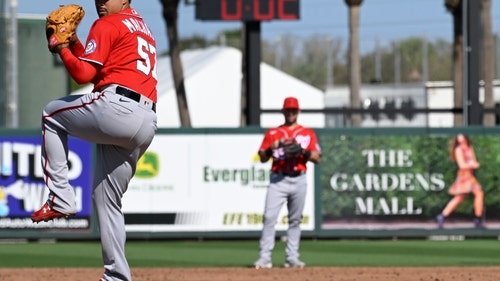
Review: Video blackouts impede baseball online
LA PORTE, Ind. (AP) Major League Baseball shows what can be done right when it comes to making its games available on the Internet. It also underscores frustrations fans have with online sports coverage in general: The business of sports is set up to feed TV sets, and Internet viewers are an afterthought.
Television channels pay a lot for rights to cover games, and they don't want to lose audiences to computers or mobile apps. As a result, fans who pay $20 or more a month for baseball's online video package, MLB.TV, are blocked from games involving hometown teams.
Until that changes - and that might come soon - MLB.TV is likely to appeal mostly to die-hard fans who care about more than just their hometown teams. A much-cheaper At Bat offering is available for casual fans like me.
With MLB.TV, I was able to catch a New York Mets-Yankees game as I traveled through Indiana by train this spring, but the option was yanked the next evening after my train arrived in New York.
Then again, had the Mets played the Chicago Cubs, I would have also been blocked in La Porte, Indiana, because it's consider part of Chicago's television market. In addition, some weekend games are blacked out more broadly because of national or regional TV coverage.
Fortunately, the blackouts are starting to ease: Baseball offered live streaming of the All-Star Game for the first time last month and has similar plans for the playoffs and the World Series. This week, baseball's online chief, Bob Bowman, told me he's optimistic a deal can be reached soon to lift blackouts on regular season games as well, possibly by the 2015 season.
The catch: You'll need a cable or satellite TV package that includes the channel that normally televises hometown games. That'll likely be the case even if the channel is already offered over the air for free.
You're basically paying twice - for the cable or satellite subscription and for the MLB.TV service.
The basic MLB.TV service costs $20 a month is mainly for personal computers. The MLB.TV Premium package permits viewing on phones, tablets, game consoles, streaming TV devices and other gadgets. It costs $25 a month.
With the Premium service, you can also choose which team's television feed and announcers you want. On some devices and Web players, there are also options to get the radio broadcasts while watching the television feed, or to get the ballpark's natural sound and mute chatty announcers.
Video of blacked-out games is available about 90 minutes after the game ends. You can also listen to home or away radio broadcasts live, even for hometown teams.
One of my favorite features is the condensed video, which is available a few hours after a game ends and includes hometown teams. It strips out all the nonsense, such as warm-ups, commercial breaks and inconsequential pitches, so a three-hour game takes only about 15 minutes to watch. You still see every major play, along with occasional replays in slow motion, but you won't get every ball and strike. If 15 minutes is still too much, a shorter highlights video is available.
Condensed video is free on personal computers. For mobile devices, you need either the Premium service or a separate offering called At Bat, which costs $3 a month.
Either subscription also gets you a neat feature called Gameday Pitch by Pitch. From your phone or tablet, you see a graphical interpretation of what's happening live on the field, with details on where runners are on base, how fast each pitch is thrown and where it crosses the plate. Next year, baseball plans to start offering similar metrics for plays in the field.
Overall, baseball does a good job of going beyond merely slapping television feeds online. For an additional $13 a month, fans can even get video of selected minor-league games.
The live video is great for frequent travelers and transplants who are fans of teams in other cities. Avid fans might also use it to follow other contenders in their team's division as the season nears its end.
For following a hometown team at home, though, most of MLB.TV's benefits are off-limits. The cheaper At Bat package offers many of the features I like, including condensed video.
That gets me back to the blackouts. There's a $22-a-month difference between At Bat and Premium. That's revenue baseball is missing out on.
I'm glad to hear that baseball is in talks to relax those restrictions for pay-TV subscribers. That will make MLB.TV more appealing to many fans, but it won't help the growing number of people who don't have cable or satellite TV.
I couldn't just buy SportsNet New York to get Mets games, whether on television or online. I'd need to pay at least $70 a month for full cable service. No, thanks.
Baseball isn't alone. DirecTV's $330-a-year online football package, called Sunday Ticket Max, also excludes local games because of television rights. The Olympics, the March Madness basketball tournament and the World Cup soccer tournament didn't have blackout restrictions, but viewing was typically limited to pay-TV subscribers.
Yes, television providers are worried about losing viewers to online audiences, but many of these viewers aren't going to television anyway. For the World Cup and other events that required a pay-TV subscription, people were borrowing friends' passwords rather than subscribe.
The Internet is becoming an important way to watch sports. Baseball officials say they deliver an average of 1.5 million live video streams a day. Imagine how much more traffic they'll get once hometown teams are available.
Fans like me are willing to pay reasonable fees, but don't want to be forced into larger packages we don't need. Let's hope it doesn't take another 12 years for baseball and the television industry to figure that out.










